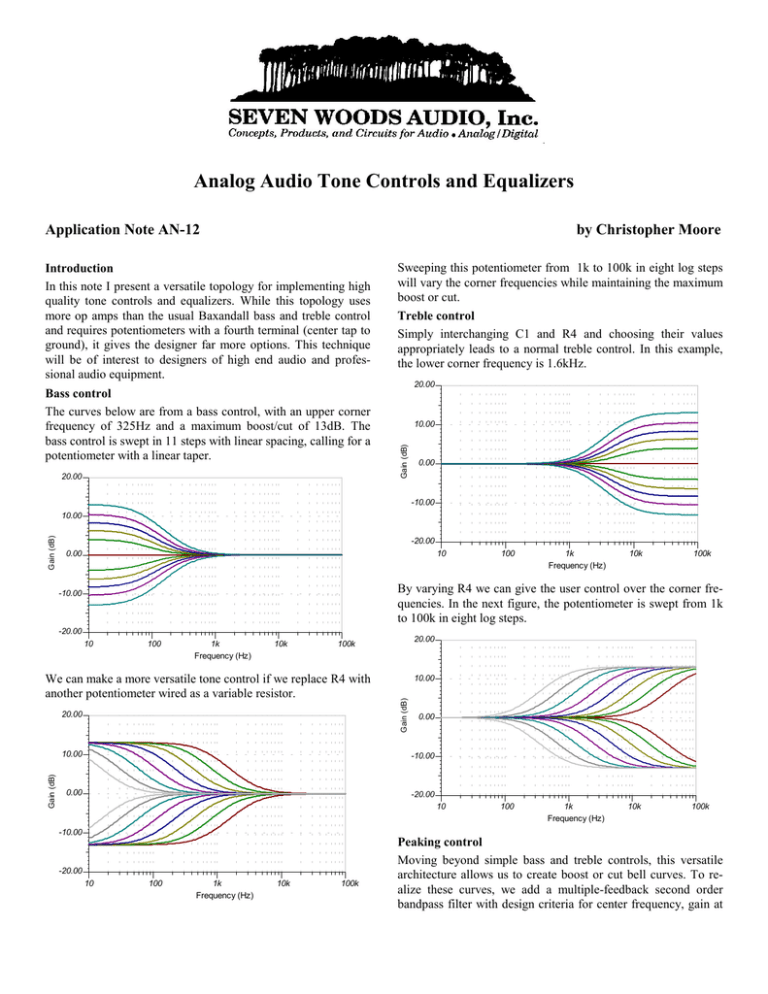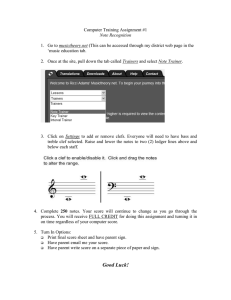
Analog Audio Tone Controls and Equalizers
Application Note AN-12
by Christopher Moore
Bass control
The curves below are from a bass control, with an upper corner
frequency of 325Hz and a maximum boost/cut of 13dB. The
bass control is swept in 11 steps with linear spacing, calling for a
potentiometer with a linear taper.
T
20.00
Sweeping this potentiometer from 1k to 100k in eight log steps
will vary the corner frequencies while maintaining the maximum
boost or cut.
Treble control
Simply interchanging C1 and R4 and choosing their values
appropriately leads to a normal treble control. In this example,
the lower corner frequency is 1.6kHz.
T
20.00
10.00
Gain (dB)
Introduction
In this note I present a versatile topology for implementing high
quality tone controls and equalizers. While this topology uses
more op amps than the usual Baxandall bass and treble control
and requires potentiometers with a fourth terminal (center tap to
ground), it gives the designer far more options. This technique
will be of interest to designers of high end audio and professional audio equipment.
0.00
-10.00
-20.00
10
0.00
-20.00
10
100
1k
Frequency (Hz)
10k
100k
We can make a more versatile tone control if we replace R4 with
another potentiometer wired as a variable resistor.
Gain (dB)
T
100
1k
Frequency (Hz)
10k
100k
By varying R4 we can give the user control over the corner frequencies. In the next figure, the potentiometer is swept from 1k
to 100k in eight log steps.
-10.00
20.00
T
20.00
10.00
Gain (dB)
Gain (dB)
10.00
0.00
10.00
-10.00
0.00
-20.00
10
-10.00
-20.00
10
100
1k
Frequency (Hz)
10k
100k
100
1k
Frequency (Hz)
10k
100k
Peaking control
Moving beyond simple bass and treble controls, this versatile
architecture allows us to create boost or cut bell curves. To realize these curves, we add a multiple-feedback second order
bandpass filter with design criteria for center frequency, gain at
the center frequency (set to 1 for our purposes), and Q (width of
the skirts). Since the MFB bandpass is inverting, we precede it
with a unity gain inverter (which can be shared by other peaking
circuits). In the curves below, the center frequency is 80Hz and
Q equals 2. Note that the family of curves is symmetrical and
that the Q is constant as boost/cut is varied.
T
20.00
Gain (dB)
10.00
0.00
-10.00
-20.00
10
100
1k
Frequency (Hz)
10k
100k
Interaction between bass and peaking control
In this topology, there is essentially no interaction between controls as long as their regions of influence are sufficiently removed from each other. But even when the controls overlap, the
curves are still “reasonable” and remain monotonic. In the figure
below, the boost and cut of the peaking control is varied while
the bass control is held at maximum boost and cut. In the cases
where the peaking control is bucking the bass control, the
peak/notch depth is greater than the cases where the peaking
control is aiding the bass control. Despite the asymmetry, the
controls would still be useful.
T
20.00
Gain (dB)
10.00
0.00
-10.00
-20.00
10
100
1k
Frequency (Hz)
10k
100k
Parametric equalizer
The parametric equalizer is arguably the most useful and versatile audio equalizer. This equalizer gives the user three controls–
center frequency, boost/cut, and Q. When the equalizer has a
number of parametric sections, the designer or user can construct complex EQ curves suitable for correcting loudspeaker or
room deficiencies. Curves of a parametric section would resemble those shown above for the peaking control, except that two
more figures would be needed to illustrate sweeping frequency
with boost and Q fixed and varying Q while holding boost and
frequency fixed.
A parametric section can be dropped right into this architecture
in place of a peaking control. A preferred parametric realization
would use the state variable technique (three op amps, a potentiometer for Q, and a dual potentiometer for center frequency).
Graphic equalizer
This architecture is also good for implementing a graphic
equalizer. A graphic equalizer is a bank of from 5 to 31 peaking
sections with frequencies evenly distributed on a log basis.
Design the peaking filters for the required frequencies, all with
the appropriate Q (all filters in a graphic equalizer have the same
Q).
The overall structure
The overall structure consists of a cascaded pair of inverting op
amp stages. The source is applied at the left side and the output
is presented by the second op amp at the right side. The
frequency sensitive stages are driven by the first op amp and
have a maximum gain of one in their pass band:
• The high pass filter develops its maximum gain at higher
frequencies and is used for the treble control.
• The low pass filter develops its maximum gain at lower
frequencies and is used for the bass control.
• The bandpass filter develops its maximum gain at its center
frequency and is used for the peaking control.
To provide boost, the filter output is passed through the
potentiometer to the output op amp, where it combines in phase
with the source signal coming through the input op amp and
adds to the source level.
To provide cut, the filter output is passed through the
potentiometer to the input op amp, where it combines out of
phase with the source signal also coming into the input op amp
and reduces the source level.
This structure delivers symmetrical boost and cut curves.
When a control is not in use (when it is defeated by setting its
potentiometer to the center), it contributes no noise to the
output.
For any value of boost or cut, the circuit can deliver its
maximum output swing at any frequency: neither the input op
amp nor the filter will overload before the output does so.
This is not the case if a state variable bandpass filter has been
incorporated as a filter in this circuit to achieve a fully
adjustable parametric section. For these filters, internal nodes
operate at a gain greater than one, especially at the center
frequency and for cases of higher values of Q. Careful design
and gain scaling are required to minimize overload and noise
issues when using the state variable filter in this structure.
Design flow for overall structure
Choose a value for R0 (feedback/feedforward resistors);
28.0K here.
Bass control
For the bass control, we design for the upper corner frequency,
the frequency below which the bass control begins to boost or
cut. The lower frequency (the frequency at which the shelf has
essentially leveled off) tags along and is easily found by considering the boost amount in volts/volts. In the example here, the
maximum boost is 13dB, or 4.5 volts/volt. The lower frequency
is the upper frequency divided by 4.5.
Design flow for bass control
Choose Av, the maximum boost/cut. While all sections usually
have the same maximum boost/ cut amount, each section can
have its own value; 13dB here.
Solve for R3:
R3 = R0 / ( 10 ^ ( Av/20 ) -1 ); 8.06K here.
Pick f1, the upper corner frequency, the frequency below
which the bass control begins to boost or cut; 325Hz here.
Pick a convenient value for R4; 10K here.
Solve for C1:
C1 = 1 / 2*pi*f1*(R0 + R3) / (R3*R4); 220nF here.
Treble control
For the treble control, we design for the lower corner frequency,
the frequency above which the treble control begins to boost or
cut. The upper frequency (the frequency at which the shelf has
essentially leveled off) tags along and is easily found by considering the boost amount in volts/volts. In the example here, the
maximum boost is 13dB, or 4.5 volts/volt. The upper frequency
is the lower frequency multiplied by 4.5.
Design flow for treble control
Choose Av, the maximum boost/cut. While all sections usually
have the same maximum boost/ cut amount, each section can
have its own value; 13dB here.
Solve for R3:
R3 = R0 / ( 10 ^ ( Av/20 ) -1 ); 8.06K here.
Pick f1, the lower corner frequency, the frequency above which
the treble control begins to boost or cut; 1.6kHz here.
Pick a convenient value for R4; 10K here.
Solve for C1:
C1 = 1 / 2*pi*f1*R4*(R0 + R3) / R3; 2.2nF here.
Peaking filter
The peaking sections use a multiple feedback inverting bandpass
filter. The design flow below is appropriate for moderate to high
Q filters (from 0.707 to any reasonable value). For lower Q’s, a
more complex procedure, one where the two capacitors assume
different values, is available, but space doesn’t permit including
this procedure.
One advantage of this circuit is that each section can be tailored
with respect to capacitor size and resistance values. Generally,
we like to keep capacitor values small to keep their size down,
but at low frequencies this leads to higher resistor values.
Generally, we like to keep resistor values down to reduce noise,
DC offset effects, and variation due to PCB contamination.
Sections operating at low bass frequencies can use large resistors
and more moderate capacitor values, while high frequency
sections can use small to moderate capacitors and resistors.
Design flow for peaking section with fixed center frequency and Q >0.707
Choose values for frequency (Fc, in Hz), Q (from 0.7 to 5 or
so), maximum boost/cut (Av, in dB), and C (in farads).
Fc = 80Hz; Q = 2; Av = 13dB, C = 47nF here.
Solve for:
K1 = 4*Q^2 – 2; 14 here.
R2 = 1 / 2*pi* Fc*C*(1 / (K1 + 2) )^0.5; 169K here
R1A = R2 / K1; 12.1K here.
R1B = R2 / 2; 84.5K here.
R3 = R0 / ( 10 ^ ( Av/20 )-1 ); 8.06K here.
In conclusion
This topology gives you a lot of freedom. You can mix all types
of equalizers, including user adjustable bass, treble, and
parametric controls, and fixed peaking equalizers. The design
process is straightforward and the performance is good.
Bibliography
Bohn, Dennis A., Constant-Q Graphic Equalizers, Audio
Engineering Society Preprint 2265, 1985 October 12-16, Audio
Engineering Society, NYC
R0
R0
Input
28K
R0
28K
Treble
28K
R0
28K
Boost
R3 8.06K
C1
2.2nF R4
10K
20K
Output
Cut
Bass
R4
Boost
10K
R3 8.06K
C4
220nF
R0
10K
R0
Cut
Cut
C
47nF
10K
R1B
84.5K
R1A
12.1K
20K
R2
169K
80Hz Peak
Boost
R3 8.06K
C
47nF
20K
Cut
Schematic showing bass, treble, and peaking tone controls
Mission statement of Seven Woods Audio
I am an electrical engineering consultant specializing in the conception and design of products and circuits used in audio applications. My company, Seven Woods Audio, is committed to
helping manufacturers quickly create digital or analog audio
products that generate a good return on investment, work right
the first time, sound excellent, and please the end user. Seven
Woods Audio works with manufacturers of professional audio,
consumer audio, broadcast, telecommunications, and computer
equipment.
rev: February 21, 2002 Copyright 2002. All rights reserved.
voice/fax 617 489 6292
moore@SevenWoodsAudio.com
http://www.SevenWoodsAudio.com

